I posted this recipe about 10 years ago. It's still a good one, but I've learned a more about making New York style bagels. As with so many types of recipes, you just have to find the one that works best for you. Even King Arthur has 39 bagel recipes on their site. So this is just one of my bagel recipes, and I'm sharing a few things I've learned over time as a novice home bagel baker.
Jump to Recipe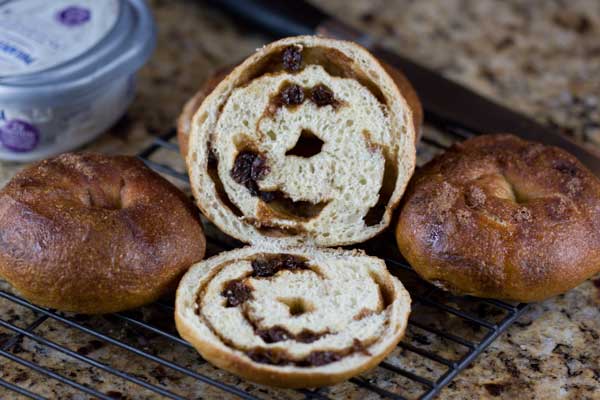
New York Style Bagels and Malt
There are tons of different types of bagels you can get in New York, but what they have in common is a soft interior and a chewy crust that comes from boiling the dough before it's baked. In addition, they have the flavor of malt, which can be in the dough itself or mixed in with the water the bagels are boiled in. Sometimes both. New York style bagel recipes often call for something called diastatic malt powder. And that's where things get a little confusing.
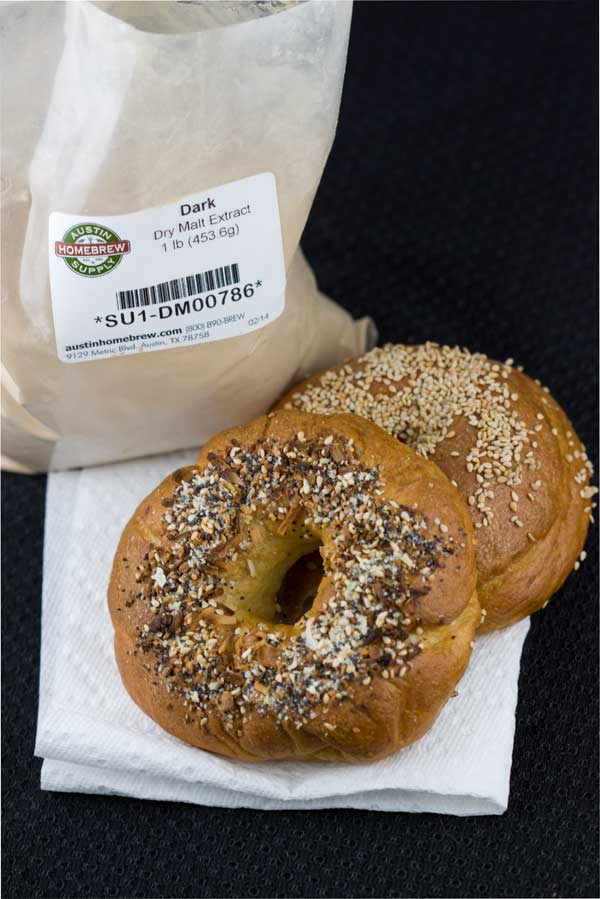
Diastatic and Non-Diastatic Malt Powder
When I first started making bagels there wasn't much info on diastatic malt powder and recipes didn't always distinguish which type to use. Diastatic could mean diastatic or non. Furthermore, these malt powders weren't as easy to find. You had to pick some up from a brewery or order it from King Arthur. There are two main types.
- Diastatic malt powder, the type you buy from a brewery, has active enzymes which break starches down to sugars that the yeast feed on. The catch is, commonly used bread flours usually have active enzymes added to them, so unless you are using organic bread flour or one without barley enzymes, you probably don't really need diastatic type malt powder in the dough. If your recipe calls for it anyway, it should be a very small amount, like 1 teaspoon to 3 cups.
- Non-diastatic malt powder does not have active enzymes and is added for flavor and color. If using non-diastatic malt powder you can use more of it (1 tablespoon to 3 cups of flour) plus extra for the boiling solution.
Barley Malt Syrup and Malted Milk Powder
And then you also have barley malt syrup and malted milk powder.
- Barley malt syrup is a form of non-diastatic malt, so you can put it in the dough and/or the water, depending on how much malt flavor you want. If you put it in the dough, it will give the bagels a darker colored interior. From what I've read, a lot of bagel shops use this in their boiling solution while using the non-diastatic powder (if any) in the dough itself.
- Malted milk powder is another type of malt that can be used to flavor bagels. It's not what professionals use, but I've made decent bagels with it that do have some malt flavor. You just have to be mindful of that the fact malted milk powder also has powdered milk, flour and baking soda. The milk powder adds a bit of extra softness, but that's the only real differences I've noticed when using it in bagel dough and in the boiling water. With malted milk powder, you'd use a lot more -- like 2-3 tablespoons, since it's non-diastatic and has the other ingredients in it. I don't recommend it for this particular recipe.
Diastatic Malt Powder in Bread Flour Dough
So going back to diastatic, why do bagel recipes with bread flour also call for diastatic malt powder when the bread flour already has the added enzymes? This recipe is an example of that. Does it really need the diastatic malt powder at all? To answer that question, I made a batch using King Arthur bread flour and leaving out the diastatic malt powder. The bagels were fine. The only tiny difference I noticed was the bagels that sat out longer on day 2 were a little less flat when made with the diastatic dough. If I baked the rounds right out of the refrigerator, there was no difference. I'd rather do that anyway.
How Long Should You Leave Shaped Bagel Dough Out Before Boiling?
This is a two day recipe. You make the dough in the late afternoon of day 1, shape the bagels, then cover and chill for 12 to 18 hours. The next day you take the cold bagel dough out to boil and bake. Some recipes say to boil the cold rounds directly from the refrigerator while others say to let stand for an hour or more. As mentioned, I've boiled this bagel dough directly from the refrigerator, after letting it sit for 20 minutes and after letting it sit for an hour. What works best at our house is directly out of the refrigerator or up to about 20 minutes. With the diastatic malt powder dough, I was able to let the formed bagel dough sit out a little longer on day 2 without the bagels going flat.
Boiling Solution
The boiling solution for bagels is another factor that can vary. You can use baking soda for darkening and adding a little bit of a lingering finish and a sweetener such as honey or molasses. You can also use barley malt syrup as mentioned above or combine that with the soda. Salt adds saltiness, so you can use it or not depending on your own tastes. As for boiling time, I find shorter times work best. If the bagel dough is cold, 30-40 seconds on each side works for us.
Baking Temperature
Some recipes call for very high heats. This one originally calls for preheating the oven to 500 and lowering the heat to 450. In our oven the bagels get a little too brown and crispy with this method. Again, this is going to vary from kitchen to kitchen. I recommend baking your first batch at 450F for 20 to 25 minutes. If that's too much you can go down to 425 or if it's too little you can use the 500 down to 450 directions. I get crispy, brown crusted bagels when I use the baking soda water and bake at 425F for 20 to 25 minutes.
Artisan Flour vs. Bread
Artisan flour gives you a much stiffer and easier to handle dough. It also gives you chewier bagels. With this recipe, you get a lot of chewiness from kneading, standing, and using regular bread flour. So you can use regular bread flour for chewy bagels or try artisan flour for extra-chewy bagels.
Recipe
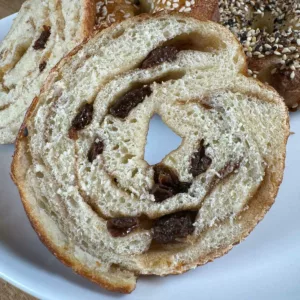
New York Bagel Recipe
Ingredients
Dough
- 3 ½ cups bread flour or high gluten bread flour (Artisan) (454 grams)
- 1 teaspoon diastatic malt powder if using a bread flour that doesn't include barley malt. This is optional!
- 1 teaspoon instant yeast
- 1 ½ teaspoons salt
- 1 ½ tablespoons honey (40 grams)
- 1 cup plus 2 tablespoons warm water
Poaching liquid (see note)
- 2 to 3 quarts water
- 1 ½ tablespoons honey
- 1 tablespoon baking soda
- 1 teaspoon salt
Cinnamon Raisin Variation (Optional)
- 1 teaspoon brown sugar
- ¼ teaspoon cinnamon
- ⅓ cup raisins (just an estimate, use as many as you like)
Instructions
- Weigh your flour and put it in the bowl of a stand mixer. Stir in the malt powder (if using), yeast and salt. Pour honey on top, then add water and stir with a big spoon or rubber scraper until blended.
- Set your bowl under the mixer with the dough hook attached, and knead with the dough hook for 3 to 5 minutes or until the ball is sturdy, smooth and elastic.
- Remove the dough from the bowl. Wipe bowl clean and rub it with a tiny amount of olive oil, then put the ball of dough back in the bowl and rotate it so that it's very lightly coated with oil. Cover bowl and let dough rise for 45 minutes to an hour
- This recipe makes about 25 oz of dough, so you can base the size on that. For smaller bagels, make each a little over 3 oz each (8 bagels) or for large bagels make them 4 oz each (6). If you want to make the cinnamon raisin variation, skip down to the bottom.
- Line two baking pans with parchment and oil the parchment. Oil keeps the dough from sticking to the parchment and deflating when you pull it off to boil. Do not use coconut oil because it will set in the refrigerator and stick. Just use regular olive or vegetable oil. Chill overnight for 12 to 18 hours.
Day 2
- Remove the bagels from the refrigerator and let sit at room temperature for up to 20 minutes while you preheat the oven and get the boiling water solution going.
- Preheat the oven to 450 degrees F. Bring 2-3 quarts of water to a boil. Line a heavy duty baking sheet with parchment paper. You should not need to grease it this time.
- When water is boiling, carefully add the baking soda, syrup and salt - be careful and stand back because it may boil up. Drop 2 or 3 bagel dough rounds into the boiling water and boil for 30 seconds. Turn and boil other side sfor 30 seconds. Lift boiled bagels carefully with a spatula, letting water drip back into the pan. Place boiled bagels on a rack to let more water drain off, then brush with egg white (if using) and add toppings (if using). Transfer to a baking sheet. Parchment paper is okay for protecting the sheet, but not required.
- Put the bagels in the oven on center rack. Bake at 450 for about 20 minutes.
- Let the bagels cool down for at least 30 minutes before eating.
For Cinnamon Raisin Variation
- On day 1 when you are forming your bagels, take one section of dough and press it into a rectangle approximately 4x3 ½ inches. Also, you really shouldn't need to flour your surface. Dough should be so smooth and pliable that you can just pat it out onto a clean surface such as a plastic cutting board or parchment lined counter. If it's really sticky for some reason, you could try rubbing a little oil on it.
- Sprinkle a packed teaspoon of dark brown sugar onto your little rectangle. Sprinkle as much cinnamon as you like over that, then sprinkle raisins - as many as you want, over the cinnamon. Now roll the rectangle lengthwise into a little tube as if you were making cinnamon rolls. Squeeze the tube and elongate it until it's about 8 inches, then bring the ends together to make your bagel ring. Set on the oiled parchment in one of the pans and repeat to make as many cinnamon bagels as you want.
- If you want, you can sprinkle the boiled bagels with a little cinnamon sugar. If you are making plain or topped bagels, top with whatever topping you are using.

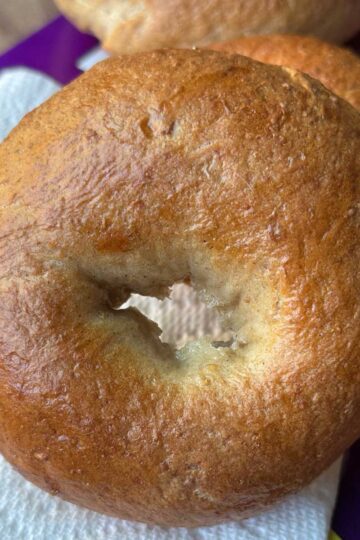
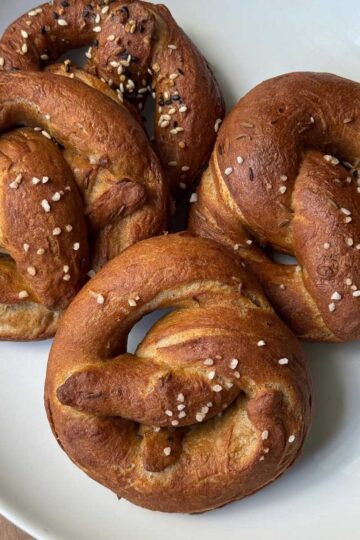
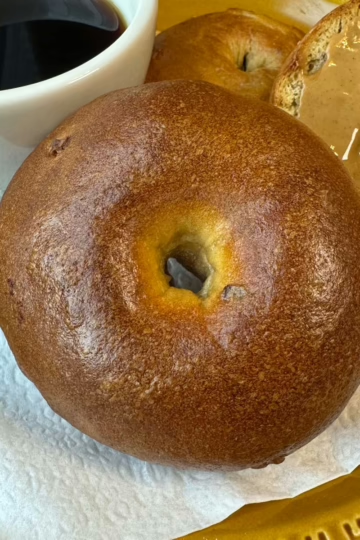
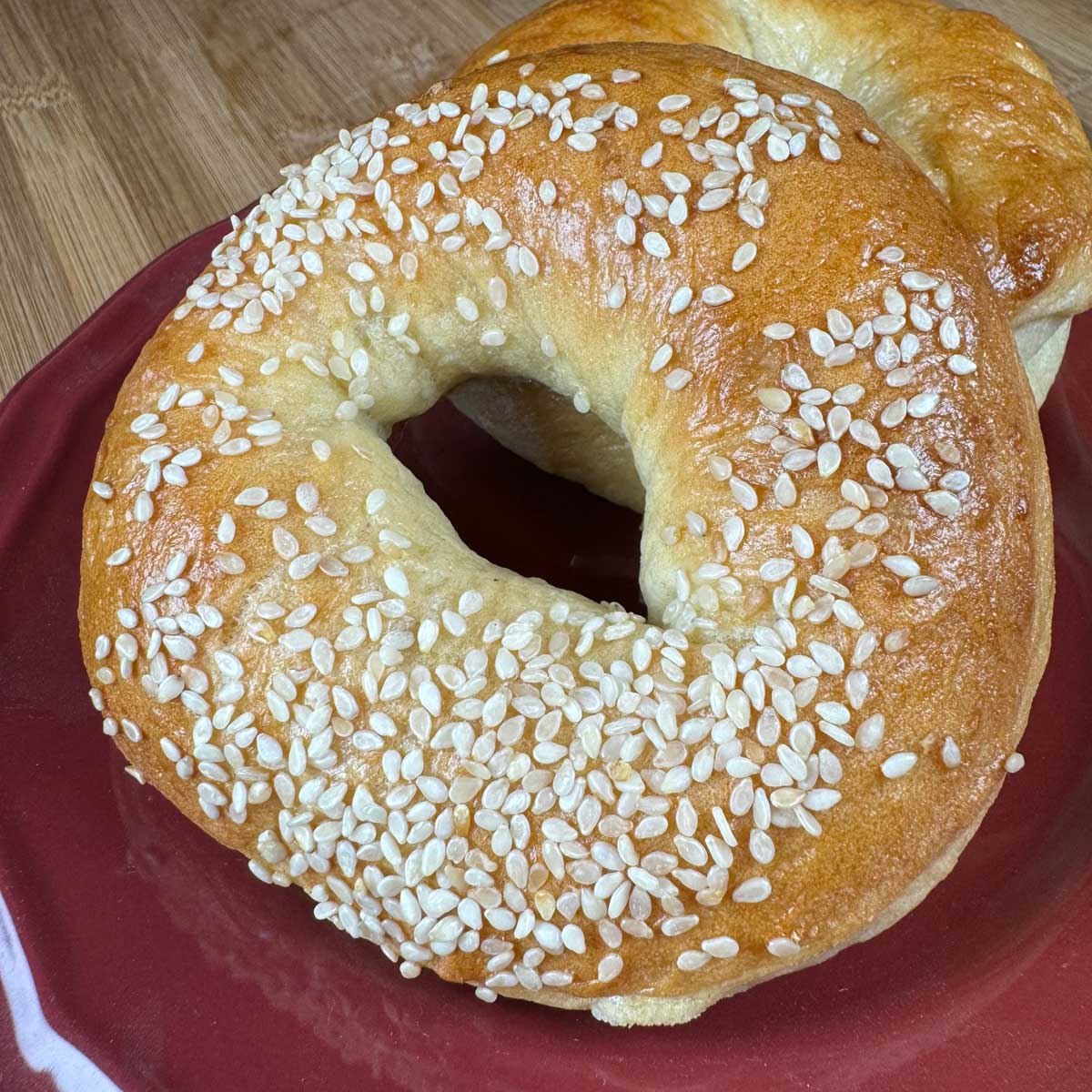
Sue says
Oh yum!!! Your bagels look fantastic. I love the look of the swirls of cinnamon and raisins.
Christine from Cook the Story says
Labor of love is what I'd call these bagels. I bet it was hard to wait, but it looks like they're worth it!